#Samuel Adams Small Batch Collection
Explore tagged Tumblr posts
Text


FILE UNDER: HOLIDAY BEER, GINGERBREAD SPICES, HOLIDAY CHEER, IMPERIAL STOUT, BAKED GOODS, CHRISTMAS BEER, ETC...
PIC(S) INFO: Spotlight on Samuel Adams Merry Maker Gingerbread Stout -- Ale brewed with spices – cinnamon, nutmeg, cloves, and ginger. 9.0% ABV. 📸: Kyle Vick (via Fine Art America).
"Warmingly reminiscent of colder fall days and pumpkin delectables, Samuel Adams' Merry Maker Gingerbread Stout will indeed make one "merry" at 9% alcohol! Aromas of spices: cinnamon, nutmeg, clove, and ginger all come through, spicy and singing of rich holiday baked goods."
-- FINE ART AMERICA (Kyle Vick)
Sources: https://fineartamerica.com/featured/sam-adams-merry-maker-gingerbread-stout-kyle-vick.html, various, etc...
#Samuel Adams Merry Maker Gingerbread Stout#Samuel Adams Merry Maker#Merry Maker#Samuel Adams#Sam Adams Merry Maker#Sam Adams#Gingerbread Stout#Double Stout#Imperial Stout#Happy Holidays#Christmas#Holiday Season#Holidays#Christmas Time#Sam Adams Merry Maker Gingerbread Stout#Merry Maker Gingerbread Stout#Holiday Beer#Sam Adam's Small Batch Collection#Spiced Beer#Small Batch Collection#Boston Beer Company#Samuel Adams Small Batch Collection#X-Mas#Gingermen#Gingerman#Gingerbread Men#Stout#Samuel Adams Gingerbread Stout#Boston Beer Co.#Christmas Season
0 notes
Text
Experiments In Early Victorian Skincare: Rosewater Cold Cream Pomatum
Let's make some cold boys some cold creams! This one is a pretty big stretch for use at sea, for reasons I'll outline later, but bear with me.

(Sarah and Samuel Adams' The Complete Servant, 1825, and every other collection of receipts since between then and 1850. This shit got passed around like copypasta. In this context a gallipot is a small ceramic vessel used by pharmacists for storing ointments and compounds -- my containers in this case are a lot less cute but a lot more functional.)

My modern version of this recipe, (scaled up considerably) 8 fl oz sweet almond oil 0.5 oz beeswax 0.5 oz jojoba oil (by weight) 8 fl oz rosewater
(Later reprints omit the balm, and it’s not clear to me if they want herbs or balm water, so I omitted it too. I’ve got Carmelite water infusing as we speak so I’ll never in the future be truly balmless.)
The last floral water pomatum I mixed up came with instructions to pour off the floral water once it got good and melded with the fat and wax components, but in this recipe the floral water itself becomes incorporated in the final product rather than just its fragrance.( Due to the amount of water in the recipe, I did introduce into the mixing final stage a small amount of a broad-spectrum natural preservative, Geogard ECT. I had concerns that this would impact the consistency but it doesn't seem to have done it any harm -- I'll talk later about why water made me eeky.)

Cooled and beaten to a consistency like whipped cream, the recipe seemed to be coming together nicely, forming an opaque emulsion that reminded me irresistibly of Hollandaise sauce. (Not, like, in color or smell or taste, I just really like Hollandaise and I don't make a ton of other emulsions on a regular basis.) Everything looked and smelled great. I chilled the batch I made in the refrigerator both to hasten potential separation and to see how stable that emulsion ended up being.

…and the answer was, not very! Leaving a jar of this cream out in my warm kitchen gave me a taste of this product's stability -- when chilled it maintains its fluffy, whipped texture but as soon as it settles at room temperature the rosewater begins to separate, forming essentially little droplets of rosewater scattered throughout a more solidified cream. There's nothing unpleasant about using it in this form, and the combination of moisturizing elements and actual moisture still do the trick, but it's a bit less glamorous.
Did I simply not beat it enough? Did it separate due to warmth? Did I fuck up my ratios? The 18th century perfumer and snuffmaker Charles Lillie gave me some not very helpful advice regarding temperature:

Also I'm pretty sure that's not how evaporation works.
But even if honey-water isn't on the table his recommendations regarding wax are still spot-on -- the only emulsifying element of these earliest cold cream formulations is beeswax, and at this proportion it's not powerful enough to keep the oil/water combination stabilized for very long. These pomatums will be just fine to use, and they feel great on the skin -- I've been using this cold cream on my hands for a while now, which have been pretty fucked up from the amount of cleaning and scrubbing I've been up to as part of this project, and it rules -- but the potential for separation is a bummer. I'll be keeping these tins in the fridge. Due to the delicate nature of this particular skincare aid, I find it hard to imagine anyone bringing it from home in a polar context, or having it prepared while aboard unless they were seriously committed to maintaining their skin's moisture barrier. Lady Jane Franklin, ashore in England, would have no trouble keeping her hypothetical stockpile of cold cream in optimal conditions, but her husband less so. Still skincare of the era and old enough for both the Franklins to have grown up with in their Georgian-Regency youths, but not exactly a handy portable preparation like its waterless sistren.
In general, water content is the death knell for a lot of DIY skincare products, making space for bacteria and mold -- every time I mention using an anachronistic preservative, even a natural one, I wince, but especially for a product like a cream or balm where you're going to be scooping it out with your fingers or touching it for the duration of its use, I found the prospect of sending a bunch of people the perfect little breeding-ground for meecrobes just too horrifying a prospect.
Can you make a cold cream without water? Beasley gives one such recipe, if in an annoyingly coy way, and the ingredients are no shocker -- just add more oil.

I scaled this recipe up a bit after double-checking in a panic to make sure I wasn’t going to be making another salve with identical composition to my lip salves. I also tried a slightly different substitution for spermaceti than before, thinking I might have been mistaken about the typical consistency of the product pharmacists were working with -- it was a bit of received wisdom to me that jojoba is a pretty good swap for historic cosmetics, but later formulatories from the early 20th century specify grating the spermaceti in a way that suggests a stiffer consistency. Mango butter is pretty stiff and brittle at room temperature, but it melted down just fine (would have melted even easier if I microplaned it first, I bet) and it's supposed to be good for both skin and hair without being quite as heavy as, say, beef marrow. With no obvious fragrancing element on par with the previous recipe's floral water, I wanted to figure out something that was a) pleasant b) comprised of materials attested in pre-1850 formulatories c) in line with modern recommendations regarding topical hair and skin use. I settled on rosemary, cedarwood, rose otto, benzoin resin, and myrrh.
(…unfortunately, this combination smells really good to me, so I will also be incorporating it into my rapidly-growing stable of perfume oil trials. I'm not tempted to rub this one on my face, but I'll be using it for hand skin and wearing it as a solid perfume.)

So what's the result like? It's very nice, but it's not creamy, and it's not cold. (And it definitely didn't whip up like cream, at least not the way I tried it. Maybe I should have beaten it for longer.) While it's nice for skincare purposes, and certainly more stable for travel purposes, I can't imagine it really scratching the same beauty itch as a more moist, pillowy formulation.
What are other ways to emulsify your cold cream? Well.

(Robert Eglesfield Griffin, A Universal Formulary: Containing the Methods of Preparing and Administering Officinal and Other Medicines, 1850)
Borax is certainly an emulsifier, albeit one I find wildly intimidating. It occurs in nature, it was certainly known by the 1840s, it appears in published cold cream recipes since at least 1825 and it still shows up in skincare today -- but its usage in modern skincare has a lot of controversy surrounding it. Moreover, half a drachm (by weight) of borax to six fluid ounces of carrier liquid is a stronger concentration of borax than a lot of modern products possess, and I just don't want to fuck around with skin pH if I can avoid it.
That's not to say that I'm without other options! Later cold creams commonly incorporate glycerin as an emulsifier as well as a bonus humectant; variously-derived forms of glycerin had been known for several decades by the point we're dealing with, but its primary purpose in the formularies of the 1840s is in the treatment of hearing loss. (Which I was ready to dismiss as one of the odd quirks of the era, like rubbing turpentine on everything, but "the glycerol test" has persisted into the 21st century as a diagnostic tool for Menière's disease.) Beasley includes one such glycerin-based recipe in 1850 but I'm not seeing it any earlier, so I'll have to do some more digging and see what I want to doctor up.
So how do you disseminate a product that separates easily, wilts in warm weather, needs a ton of stirring and whipping to get that nice creamy consistency, and requires a shitload of floral water? Very carefully. You basically had to make this stuff in small batches, rather than one big batch to be doled out over the course of months or years. Historian of cosmetics James Bennett summarizes:
Their short shelf life meant that cold creams were usually made up at home or purchased in small quantities, freshly made up by a local pharmacist, chemist or druggist. The ceramic pots they were sold in turn up frequently in Victorian-era rubbish tips.
Bennett's piece on the historical timeline of cold creams is definitely worth a read if you're trying to figure out how we get from super-perishable 1840s vegetable oil-based cold creams to the the super-rich, damn near indestructible mineral oil cold creams of the 20th century.
If you want a treat, take a trip through auction sites and see the many gorgeous and weird designs used on cold cream pots in this century -- most of the truly fabulous ones are from the second half of the 19th century when mass production of these designs became possible, but damn if they aren't cute.

(Source: Cache Antiques)
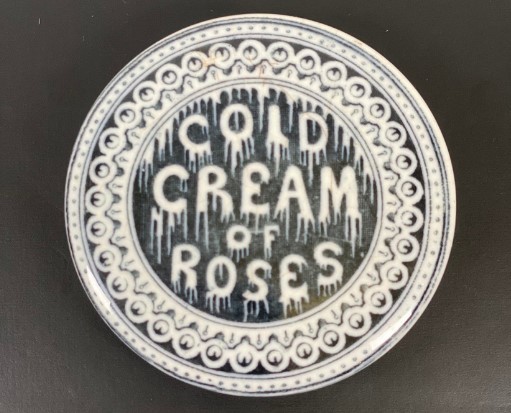
(source: Cache Antiques)
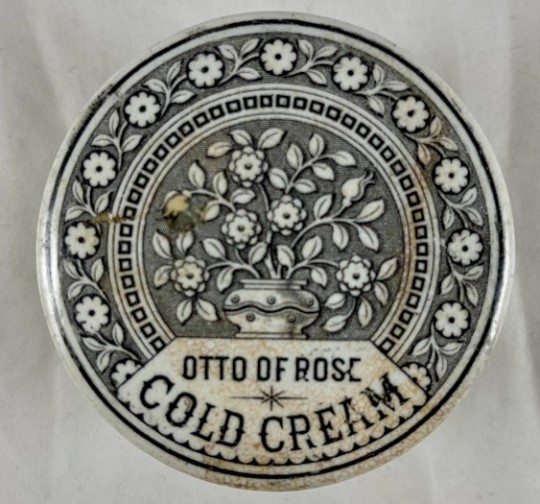
(source: 1stdibs)
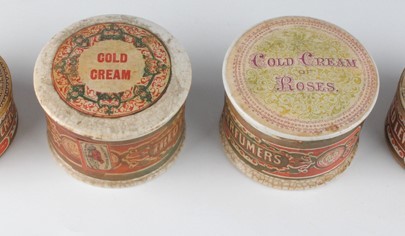
(source: Whytes)
Thanks so much for all the positive feedback and enthusiasm this project has been getting! I've got an online store now (Gallipot Project) to accompany this project where I can share my findings and offset the costs of all my weird animal fat and floral water purchases by selling what I've made. The store had the softest of soft launches earlier on my private Twitter and with the proceeds I was able to source some tallow for making not only salves and pomatums (pomata…) but hopefully some white Windsor soap. Don't feel obligated to buy a damn thing, but I've got salves and cold creams up for sale now and very soon I'm hoping to share some tinted salves and historical perfumes, as well as one weird unguent with a fascinating historical pedigree and a very strong Franklin connection.
5 notes
·
View notes
Text
Hold the Fruit: 11 Summer Beers for People Who Appreciate the Classics
Credit: CraftBeer.com
June 1, 2017
Born in 1979, my parents raised me on the music of the Beach Boys, the Monkees and the big hair ballad rock of the early 80s. My joke is that if a song was released after 1985, I don’t know it. In the old brown Jeep Cherokee I drove to high school in the 90s, my friends knew the only music they’d hear was the 50s/60s station. Even today, anyone who has been in my car knows they’re about to get an earful of 40 years of Springsteen.
This is my long way of saying I’m a woman who appreciates the classics — and the same goes for beer styles. If this summer’s lineup of fruit beers doesn’t excite you, no fear: small and independent craft brewers are producing classic styles to suit your season. Here are some of the summer beers you’ll want to seek out.
(MORE: Like Mexican-Style Lagers? Here are 11 Craft Beers You Should Try)
Rockfish Wheat | Blue Mountain Brewery in Afton, VA
Blue Mountain celebrates its 10th anniversary this year. Rockfish Wheat is a classic American Wheat — an easy-drinking beer with citrus undertones you’d find in the style. The brewery says the beer is its “ode to beaches, barbecues and lazy river floats.”
Conrad’s Kölsch | Anaheim Brewery in Anaheim, CA
The brewery modeled Conrad’s Kölsch after Köln (Cologne), Germany’s top-fermenting beers. It is a light golden, pleasantly drinkable ale, with the perfect balance of hops to malt, making it the perfect beer to grab if you want to linger in the beer garden this summer.
Credit: CraftBeer.com
Transcendent IPA | Mill Creek Brewing in Nolensville, TN
Mill Creek Brewing brewed this summer IPA to please hopheads. The brewery used a load of Citra, Mosaic and Hüell Melon hops in the recipe. The result? Mill Creek says Transcendent IPA “gushes” with flavors reminiscent of mango, melon, pineapple, grapefruit, and berries.
(MORE: This is Why You Should Stop Hoarding Beers)
Kaibab Kölsch | Lumberyard Brewing in Flagstaff, AZ
This beer gets its name from the Kaibab region of Northern Arizona, which includes the Grand Canyon. Lumberyard Brewing made the first batch in collaboration with Tuscon’s Dragoon Brewing, and you can expect to see this dry, crisp summer beer released later this summer.
Hefe”r”weissen | Millstream Brewing Company in Amman, IA
Amana, Iowa, has deep German roots — it’s home to the Amana Colonies, a 160-year-old German settlement (and the largest National Historic Landmark in the country). The region is also known for its cattle farms and corn crop. Millstream Brewing Company honors those traditions with its summer 2017 release of Hefe”r”weissen.
“While we took liberties and played with the name, we did not compromise on making a true German Hefeweizen,” owner Teresa Albert tells CraftBeer.com. The traditional German-style hefe has flavors of banana and clove as well as an unfiltered, cloudy appearance.
Northbound | Great North Aleworks in Manchester, NH
Great North Aleworks says its Northbound is a beer made for whatever you want to do this summer, whether its hit the trails or hit the beach. The brewery took a classic pilsener, then used Mandarina Bavaria and Lemon Drop hops to add a bright citrus flavor. You can find it in New Hampshire and Connecticut.
(MORE: Find a U.S. Brewery)
Jam Session IPA | Pikes Peak Brewing in Monument, CO
Jam Session IPA was created for (and named in honor of) the Meadowgrass Music Fest held in Black Forest, Colorado. Pikes Peak says the session IPA features Zythos hops balanced with a malty backbone.
Sam Adams Summer Ale | Samuel Adams in Boston
This classic American summer beer from Sam Adams celebrates its 21st “beer day” in 2017. First brewed in 1996, Sam Adams Summer Ale is a classic American Wheat that balances bright, citrusy Noble hops and peppery spice. The brewery says the combo of Hallertau Mittelfrueh and Saaz Noble hops, lemon peel and the African pepper, Grains of Paradise, gives Summer Ale its crisp, citrus character and peppery bite.
Honey Vanilla Wheat | Due South Brewing in Boynton Beach, FL
The summer of 2017 is the first time Due South is releasing Honey Vanilla Wheat as its summer seasonal. The summer beer is a collaboration between the Boynton Beach brewery and beekeepers in their area.
“We teamed up with McCoy’s Sunny South Apiaries, beekeepers about 15 miles from our brewery, to create this incredible beer,” explains Doug Fairall, the brewery’s brand marketing manager. “Bees from the apiary produced honey from local Saw Palmetto plants which we then added to the kettle. We were able to see the actual hives that made the honey and the plants they collected their nectar from.”
Hello Darlin’ | Urban South Brewery in New Orleans
Urban South is a one-year-old brewery in New Orleans — the “Urban South.” While this American-style pale ale may have notes of tangerine and tropical fruits, the flavor and aroma come from Mandarina Bavaria and Azacca hops.
Jess Baker
Jess Baker is the editor in chief of CraftBeer.com. Enamored by the personalities, dedication and entrepreneurial spirit of America’s small and independent brewers, she brings their stories to life. She’s a runner, an aunt, a die-hard Springsteen fan, and suffers from a bit of social media obsession. Read more by this author
The post Hold the Fruit: 11 Summer Beers for People Who Appreciate the Classics appeared first on Miami Beer Scene.
from Hold the Fruit: 11 Summer Beers for People Who Appreciate the Classics
0 notes
Text
A 'six-pack' of tips for aspiring entrepreneurs
He recognized early on that to be successful, the journey will come with mistakes - potentially million dollar mistakes. Drawing upon both past feats and failures, Jim Koch offers up a collection of lessons and tips he's used throughout his journey to make Samuel Adams one of the leading independent American craft breweries and a successful business. * Better and cheaper One of the first valuable lessons Koch learned was that if you're going to bring out a new product, it has to be better or cheaper than the competition. If your product is neither better nor cheaper, you are not adding value for customers; and you probably don't have a business. Once Koch decided to start a beer company, he believed that by using quality ingredients and a traditional brewing process, he could make a better beer than anything that was on the market. * Think big, start small Koch admits that early on, he occasionally forgot the simple truth that a business really starts when a customer buys your product. Luckily, his uncle reminded him of that one morning just before the first batch of beer was ready. Jim recalls, "My uncle called and asked what I had been working on. I told him that I planned to buy a computer to track sales. He pointed out that I didn't have any sales to track and suggested instead that I spend my time actually getting sales. Immediately, I got it. It all starts with your first customer." From that day forward, Koch followed the adage, "Have a big idea but start small." * We're all salesmen When Koch was a student, Harvard Business School offered about 22 courses on marketing and not a single course in sales. Therefore, there was nothing that prepared students for the abject terror of a sales call. He walked into a local restaurant and delivered an ill-prepared pitch to a man behind the bar, who stood silently throughout. In that humbling moment, Koch gained instant respect for all sales people, and vowed to acquire selling skills. Great salesmen are sometimes born, but they can also be made. Today's business culture doesn't always pay adequate respect to the job of selling. Koch urges all young entrepreneurs to never look down at salesmen, because if you start a company, you become your first and most important salesperson. * The string theory In the middle of graduate school, Koch decided to take a break and became a mountaineering teacher at Outward Bound. The program teaches participants self-reliance, teamwork, creativity and how to handle challenges. Through his teaching, Koch developed something he likes to call the "string theory." At the beginning of each four-week course, participants were given a supply of alpine cord (heavy nylon string) for lashing gear, pitching tarps, etc. Consistently, if participants received plenty of string, they would run out and need more. But, when they were given less and told they had only two-thirds of what they really needed, they would get incredibly creative and make the cords last. * Company values In the beginning, when local distributors declined to carry Samuel Adams, Koch had to become his own distributor and sales force. He carried chilled bottles of Boston Lager to bartenders around Boston. They admired the fact that Koch was so hands-on, opting to brew small batches, rather than trying to compete with the larger brewers mass-producing mainstream beers. These early practices are the same ones Koch uses today. When you start your own company, be sure to instill a solid foundation of operations and processes throughout every step of the journey, to ensure that your business stays true to your philosophy and values. * Getting rich is life's great booby prize Although the promise of financial success is what motivates some people to start their own businesses, the fact is money is nothing if you're not happy. Often, when young entrepreneurs embark on the journey of starting a business, they do it with the goal of getting rich. The unfortunate fact is that about 90 percent of businesses fail within the first five years. And, most of the businesses that do survive don't create great wealth for the owners. If your objective is to accumulate wealth, starting a business may not be the wisest path. On the other hand, if you get into business doing something you love, you have a very high chance of being happy. Ask any person: would you rather be rich, or would you rather be happy? Koch knew he had to focus on the activities that provide the best return on time invested. To this day, he still tastes a sample from every batch, keeping an obsessive eye on quality and flavor. From the people to the product, Koch is as involved in the company's day-to-day operations as he was when Samuel Adams started. He makes decisions based on what's best for the beer, not the bottom line.
0 notes
Text
A 'six-pack' of tips for aspiring entrepreneurs
He recognized early on that to be successful, the journey will come with mistakes - potentially million dollar mistakes. Drawing upon both past feats and failures, Jim Koch offers up a collection of lessons and tips he's used throughout his journey to make Samuel Adams one of the leading independent American craft breweries and a successful business. * Better and cheaper One of the first valuable lessons Koch learned was that if you're going to bring out a new product, it has to be better or cheaper than the competition. If your product is neither better nor cheaper, you are not adding value for customers; and you probably don't have a business. Once Koch decided to start a beer company, he believed that by using quality ingredients and a traditional brewing process, he could make a better beer than anything that was on the market. * Think big, start small Koch admits that early on, he occasionally forgot the simple truth that a business really starts when a customer buys your product. Luckily, his uncle reminded him of that one morning just before the first batch of beer was ready. Jim recalls, "My uncle called and asked what I had been working on. I told him that I planned to buy a computer to track sales. He pointed out that I didn't have any sales to track and suggested instead that I spend my time actually getting sales. Immediately, I got it. It all starts with your first customer." From that day forward, Koch followed the adage, "Have a big idea but start small." * We're all salesmen When Koch was a student, Harvard Business School offered about 22 courses on marketing and not a single course in sales. Therefore, there was nothing that prepared students for the abject terror of a sales call. He walked into a local restaurant and delivered an ill-prepared pitch to a man behind the bar, who stood silently throughout. In that humbling moment, Koch gained instant respect for all sales people, and vowed to acquire selling skills. Great salesmen are sometimes born, but they can also be made. Today's business culture doesn't always pay adequate respect to the job of selling. Koch urges all young entrepreneurs to never look down at salesmen, because if you start a company, you become your first and most important salesperson. * The string theory In the middle of graduate school, Koch decided to take a break and became a mountaineering teacher at Outward Bound. The program teaches participants self-reliance, teamwork, creativity and how to handle challenges. Through his teaching, Koch developed something he likes to call the "string theory." At the beginning of each four-week course, participants were given a supply of alpine cord (heavy nylon string) for lashing gear, pitching tarps, etc. Consistently, if participants received plenty of string, they would run out and need more. But, when they were given less and told they had only two-thirds of what they really needed, they would get incredibly creative and make the cords last. * Company values In the beginning, when local distributors declined to carry Samuel Adams, Koch had to become his own distributor and sales force. He carried chilled bottles of Boston Lager to bartenders around Boston. They admired the fact that Koch was so hands-on, opting to brew small batches, rather than trying to compete with the larger brewers mass-producing mainstream beers. These early practices are the same ones Koch uses today. When you start your own company, be sure to instill a solid foundation of operations and processes throughout every step of the journey, to ensure that your business stays true to your philosophy and values. * Getting rich is life's great booby prize Although the promise of financial success is what motivates some people to start their own businesses, the fact is money is nothing if you're not happy. Often, when young entrepreneurs embark on the journey of starting a business, they do it with the goal of getting rich. The unfortunate fact is that about 90 percent of businesses fail within the first five years. And, most of the businesses that do survive don't create great wealth for the owners. If your objective is to accumulate wealth, starting a business may not be the wisest path. On the other hand, if you get into business doing something you love, you have a very high chance of being happy. Ask any person: would you rather be rich, or would you rather be happy? Koch knew he had to focus on the activities that provide the best return on time invested. To this day, he still tastes a sample from every batch, keeping an obsessive eye on quality and flavor. From the people to the product, Koch is as involved in the company's day-to-day operations as he was when Samuel Adams started. He makes decisions based on what's best for the beer, not the bottom line.
0 notes
Text
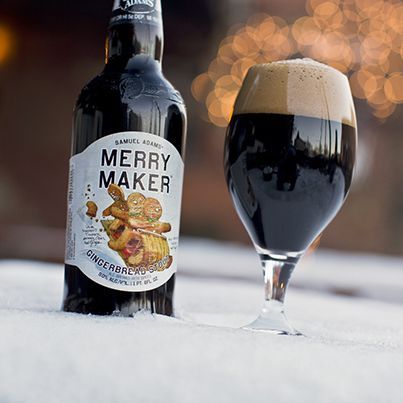





"BUT IT'S THE INTENSITY AND SPICES OF CINNAMON, CLOVE, NUTMEG, & GINGER THAT ADD A WICKED KICK FOR A JOLLY PLAYFUL BREW..."
PIC(S) INFO: Spotlight on promotional images for Samuel Adams' "Merry Maker" Gingerbread Stout, part of their Small Batch Collection, brewed with cinnamon, cloves, nutmeg, and ginger as well as East Kent Goldings & Fuggles hops. 9.0% ABV, 25 IBU.
"This rich dark gingerbread stout entices with the aromas of the holidays, hinting at the merriment and spices within. The flavor of gingerbread comes alive beginning with the smooth sweetness and heartiness of dark roasted malts and a touch of wheat. But it’s the intensity and spices of cinnamon, clove, nutmeg, & ginger that add a wicked kick for a jolly playful brew full of merry mischief."
-- SAMUEL ADAMS (Boston Beer Company, USA)
Sources: https://fineartamerica.com/featured/sam-adams-merry-maker-gingerbread-stout-kyle-vick.html, A Potable Pastime, The Full Pint, Another Pint Please, various, etc...
#Samuel Adams Merry Maker Gingerbread Stout#Samuel Adams Merry Maker#Gingerbread Stout#Merry Maker#Samuel Adams#Sam Adams#Double Stout#Imperial Stout#Happy Holidays#Holiday Season#Holidays#Christmas Time#Sam Adams Merry Maker Gingerbread Stout#Sam Adam's Small Batch Collection#Spiced Beer#Small Batch Collection#Boston Beer Company#Samuel Adams Small Batch Collection#Stout#Samuel Adams Gingerbread Stout#Christmas#Merry Maker Gingerbread Stout#Holiday Beer#Gingerbread#Boston Beer Co.#Gingerman#Gingerbread Men#Sam Adams Merry Maker#Gingermen#Christmas Season
0 notes
Text



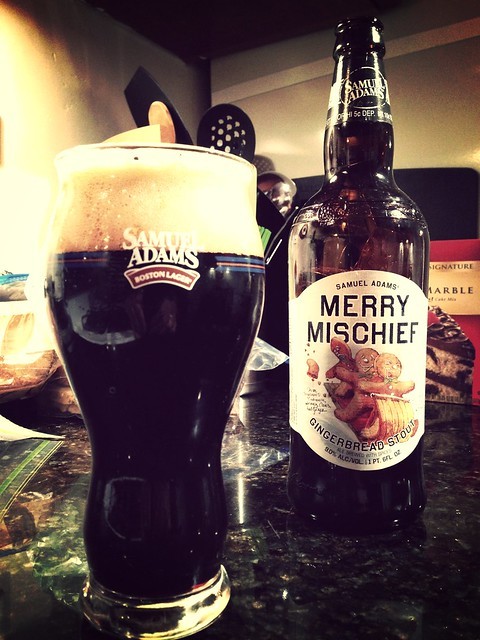
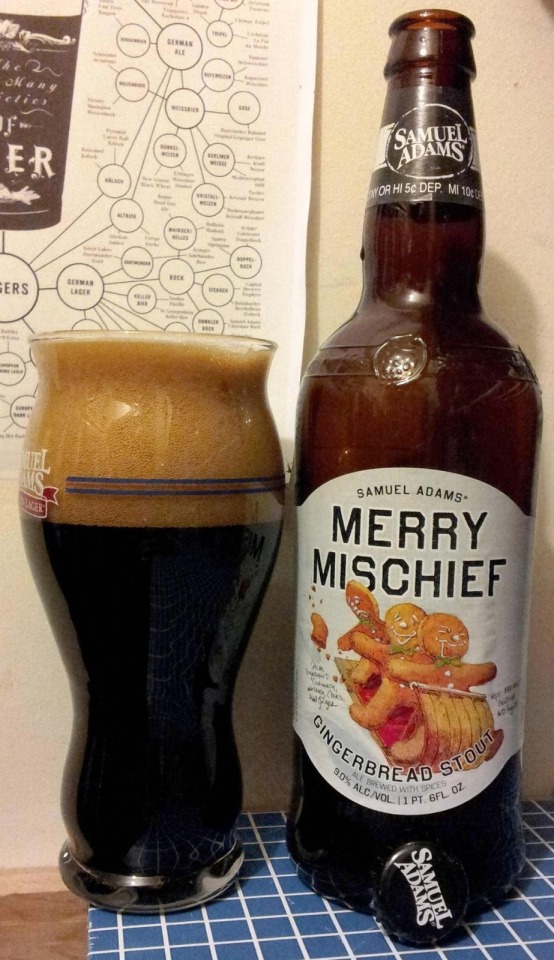
"...SPICES OF CINNAMON, CLOVE, NUTMEG, & GINGER THAT ADD A WICKED KICK FOR A JOLLY PLAYFUL BREW FULL OF MERRY MISCHIEF!"
PIC(S) INFO: Mega spotlight on Samuel Adams Merry Mischief Gingerbread Stout. Brewed by Boston Beer Company in Boston, Massachusetts, part of their Sam Adams' Small Batch Collection [Batch No. 1]. ABV: Spice/Herb/Vegetable 9.0%.
"This rich dark brew entices with the aromas of the holidays, hinting at the merriment and spices within. The flavor of gingerbread comes alive beginning with the smooth sweetness and heartiness of dark roasted malts and a touch a wheat. But it’s intensity and spices of cinnamon, clove, nutmeg, & ginger that add a wicked kick for a jolly playful brew full of merry mischief."
-- BOSTON BEER CO. (Samuel Adams)
Style: Imperial Stout (w/ Cinnamon, Nutmeg, Cloves, Ginger)
Hops: East Kent Goldings, Fuggle
Malts: Samuel Adams Two Row Pale Blend, Wheat, Special B, Paul’s Roasted Barley, Flaked Oats
9% ABV
Sources: https://beerstreetjournal.com/sam-adams-merry-mischief-gingerbread-stout-arrives, Flickr, various, etc...
#Samuel Adams Merry Mischief#Samuel Adams#Sam Adams Merry Mischief Gingerbread Stout#Merry Mischief#Gingerbread Stout#Stout Beer#Samuel Adams Gingerbread Stout#Stout#Beer#Merry Mischief Gingerbread Stout#Holiday Beer#Holiday Season#Happy Holidays#Christmas#Gingerbread Man#Gingerbread Men#X-Mas#Gingerman#Imperial Stout#Christmas Time#Sam Adam's Small Batch Collection#Spiced Beer#Boston Beer Co.#Sam Adams Merry Mischief#Small Batch Collection#Boston Beer Company#Christmas Season#Sam Adams#Gingermen#Samuel Adams Small Batch Collection
0 notes